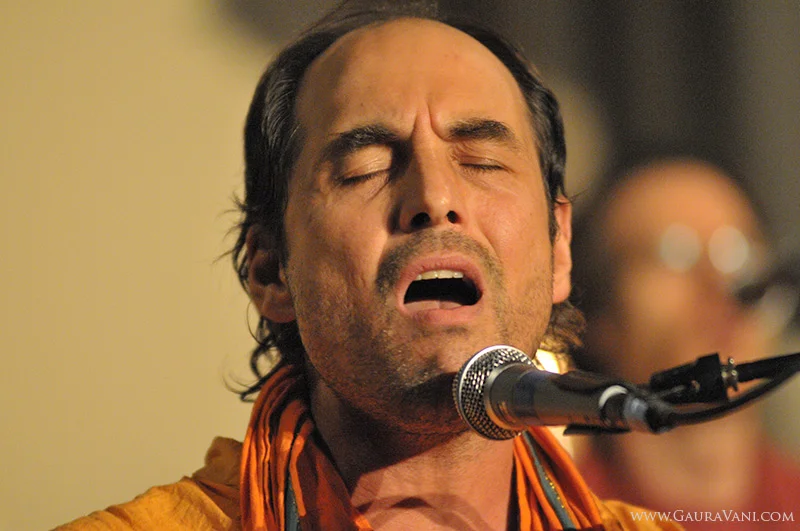Interview With Saul David Raye, Bhakti Yogi And Kirtan Artist: Catch Him Live At Bhakti Fest, Sept 7-11, Joshua Tree, CA
By Ashley Shires
Saul David Raye is an internationally acclaimed yoga instructor and kirtan artist who draws on the depth of bhakti and tantra yoga traditions. His music is influenced by his travels in India and his experience growing up in the music industry in Malibu. He will be teaching yoga and playing music from his new album, 10,000 Suns, at Bhakti Fest in Joshua Tree, CA, September 7-11, 2017.
Can you tell us a little about your spiritual background?
My ancestry is Protestant, Catholic, Buddhist, Jewish and Hindu, and part of that is from the Middle East, so I like to say that I’m a spiritual mutt (laughs). And then my father went mid-life spiritual crisis when he was in his 40’s. He went back to India and Sri Lanka, staying in a monastery and meditating in a rubber forest. He met a young American monk, Yogavacara Rahula, who had been in the Vietnam war and had been taking acid. Rahula had come down through Asia and he and my father formed a friendship, a deep soul connection.
I was a teen-aged kid at the time, growing up in Malibu, and into my living room walks this Buddhist monk in simple robes, with a shaved head. Besides his clothes and his shaved head, I first noticed his eyes. He had these really loving eyes. He was my first Dharma teacher. He taught me meditation, the Buddhist dharma. He also practiced asana and pranayama; he had studied yoga in India and he really intrigued me.
Were you working in the music industry at the time?
Yes, I worked in a recording studio that my father built. He was a jazz musician, and he built a recording studio on the beach in Malibu in 1984, Avatar Recording Studios, named after his experience growing up in Asia. I grew up there as a punk kid in Malibu, working with pretty well known people like Duran Duran, Olivia Newton John, Prince, Toni Childs. My main experience there was as a recording engineer and producer.
Were you playing music, too?
I was a self-taught musician; I did a little of my stuff on the side, but I couldn’t listen to the sound of my own voice on tape (laughs); it freaked me out. That is actually where I credit mantras to help me open my voice up.
Was there a specific event that caused you to leave the music industry?
It was the rock music scene of the late 1980’s in LA, and I had a vision of what my life would be like if I stayed and I couldn’t. And…I also had a divine intervention. I was on a music tour in Australia, doing live sound, and I got really sick – a tropical infection. I started having these headaches like sticking a knife in my eyeball, and I was misdiagnosed with a sinus infection. In the end, back in California, I had a seizure and was paralyzed on the left side of my body for five hours and had emergency surgery. That experience changed my life: they literally cut my head open and drained this abscess. Later, someone gave me a book on shamanic death experiences, and it was much like my experience; mystical, strange. It changed the course of my life.
That’s incredible. What did you do next?
I left Los Angeles to study with Rahula in a Buddhist monastery/meditation center in West Virginia. I lived there a year and a half, and then I went to Asia for about two and a half years, studying, traveling, living. In Asia, I heard kirtan for the first time, Indian singing, which was different from Budhhist chanting. I fell in love with it, and when I came back to the United States, I met Seane Corn; we both taught at Yoga Works. She bought me my first harmonium. I heard the first Krishna Das record about the same time.
I had no intention of becoming a kirtan singer – it was for myself, back then, playing, learning chants. In the 1990’s, there was no kirtan camp – I just played my harmonium. I was fortunate, though, to play with so many musicians who influenced me. I spent some time with Dave Stringer; I produced his first two albums in the early 2000’s. He was a pioneer in the kirtan movement – totally devoted. He traveled around singing kirtan, even when it wasn’t hip and cool. We made these records and I learned the art and craft of kirtan from Dave.
How did music take off in your life in a different way?
Well, Bhakti Fest happened in 2009. Before that, I had done kirtans here and there, but Bhakti Fest was really the catalyst for many artists. Bhakti Fest gave us all a place to be that supported the movement of kirtan in the United States. Sridhar (the founder of Bhakti Fest) had an amazing vision that he got at Woodstock. Bhakti Fest has a lot of special meaning.
Find out more about Saul David Raye here. Saul recently opened up the Mandala Yoga Center in LA. For more information visit http://mandalacenter.us/.
And to join us at Bhakti Fest this September visit www.bhaktifest.com.









